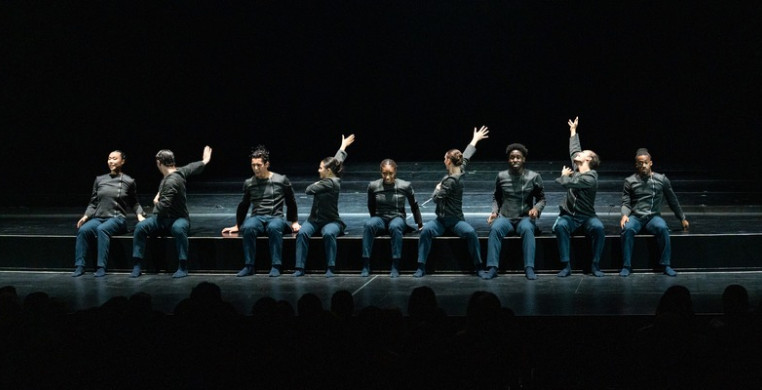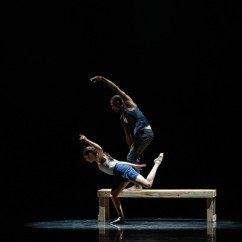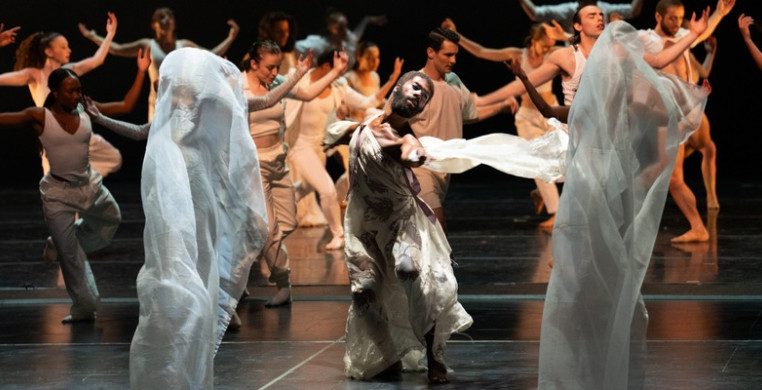Dance For Life’s 33rd Annual Gala Concert and Fundraiser, held on Saturday, August 10th at Chicago’s Auditorium Theatre, was in one word, spectacular!
What a great celebration of life and of the many different ways to express the humanity of our journey on this earth—time and energy, connection, separation, joy, despair, but overriding it all, connection; the connecting of minds, hearts, and bodies.
Where to begin? It was a veritable feast. The opening video collage provided a welcome substitute for the traditional MC monologues of past galas, providing both historical context and an exciting amuse-bouche to whet our appetites for the live stage action.
Giordano Dance Chicago never looked better in their jazzy excerpt from “Gershwin in B” (2024), choreographed by Al Blackstone and performed by the full company. Set to George Gershwin’s “Rhapsody in Blue,” (1924), Giordano Dance performed their high-octane jazz classic with crisp, dance pyrotechnics, ponytails and sassy bottoms, plenty of attitude and so much fun, it was infectious. In “Gershwin in B,” Giordano Dance set the tone for an evening that was all about love—love for dance, love for each other and love for universal humanity.
My heart melted watching Joffrey’s Victoria Jaiani and Alberto Velazquez dance the Italy Pas de Deux from Yuri Possokhov’s “Anna Karenina,” with pianist Jorge Ivars at the onstage grand piano playing composer Ilya Demutsky’s score.
Isolating the pas de deux from the rest of the full-length ballet gave both performers and audience a chance to focus on the nuances of relationship in this tender partnership. Jaiani’s dramatic depth, always a hallmark of her exquisite work, has only deepened over her long and illustrious career. A prime example of both control and dramatic expression was her achingly slow fouetté leg rotation, from à la quatrième devant to à la seconde, to arabesque. Possokhov’s use of her uniquely acrobatic facility coupled beautifully with Jaiani’s portrayal of Anna, a character whose emotional ambiguity and vulnerability expressed themselves in modern angles and balletic language as poignantly as in Tolstoy’s Russian. Velazquez proved a perfect passionate squire in his conquest of Anna.
Still swooning in the afterglow of their performance, I have to say, all eight other companies, and the cast-of-thousands ensemble that comprised the Finale, completed a buffet of delicious entrées.
African drumbeats and soul music ushered Praise Productions onto the stage. New to Dance for Life, Praize Productions is an all-women grass roots company that hails from Chicago’s Martin Luther King Drive and prides itself on offering dance performance and instruction to Chicago’s underserved communities. Their message: Black is Beautiful! in all shapes, sizes and movement. Praize recognizes how empowering it is for little girls to see grown ups who look like their community on stage, and not just the fairytale princesses of European story ballets. There is a strong gospel element to their work, both in movement and music, and an undaunted spirit of “yes we can!”
 "18+1," with Visceral Dance Chicago; Photo by Michelle Reid
"18+1," with Visceral Dance Chicago; Photo by Michelle Reid
Visceral Dance Chicago and Hubbard Street, both eclectic, versatile and innovative in their repertoires, also chose the diverse audience of Dance for Life to offer “something a little different.”
Breaking the fourth wall, Visceral Dance’s excerpt from “18+1,” choreographed by Gustavo Ramirez Sansano, got up close and personal, sitting on the edge of the stage and addressing the audience. Their puppet-like sarcasm and sassy, in your face affect set to Latino music was a social commentary that was both thought-provoking and entertaining.
Hubbard Street chose an excerpt from the opening of Rennie Harris’s “Dear Frankie” (2023) which received its premiere performance by Hubbard Street at the Joyce Theater in New York. “Dear Frankie” is a tribute to the memory of Frankie Knuckles, a Chicago DJ known as the godfather of “house.” A smoky stage brought dream-like characters in and out of focus in electrifying sequences.
Of particular note were Ensemble Español and Trinity Irish Dance, which chose this occasion to showcase new directions in their fusion of traditional and contemporary dance. Without abandoning their rich repertoires of authentic regional dance forms and cultures, of which both companies are internationally-recognized exemplars, they each have taken the mission of making their respective cultures meaningful and accessible to younger generations of American-born audiences with new, innovative repertoire that melds modern theatrical dance forms, such as jazz, ballet, and modern dance.
Trinity Irish Dance performed Mark Howard and Sandy Silva’s “Communion” (2016) initially à capella, using floor mics and body percussion, and their own harmonizing voices in both Gaelic and English to accompany themselves in traditional Irish melodies. In an unusual twist, they were barefoot, stomping traditional Irish rhythms with flat feet. The tight-knit ensemble was largely non-locomotor, focussing attention on the miraculous rhythmic and auditory production they created. A scratchy, plucked violin joined the group for a round of snapping fingers, aerial beats and intricate spatial groupings in a slo-mo breakdown of Irish step dance.
For me, the biggest surprises of the evening were Ballet 5:8, and Winifred Haun & Dancers, perhaps for the increasing depth and richness of choreographic invention and the technical and artistic development of the dancers.
Ballet 5:8, in a crisp and sunny contemporary ballet, performed choreographer Steve Rooks’ “Wind.” I have watched this company mature over many seasons and applaud their commitment to both their spiritual and artistic mission. Often, when an artistic entity is in service of an ideology, the art suffers. With Ballet 5:8, both seem to nourish and enhance each other. The dancing was polished and delightful, and came across as a breath of fresh air, a palette shift on the menu.
 "Absent Moon," with Vernon Gooden and Crystal Gurrola; Photo by Michelle Reid
"Absent Moon," with Vernon Gooden and Crystal Gurrola; Photo by Michelle Reid
In Winifred Haun & Dancers’ excerpt from “Absent Moon” (2024) the sound of rain and melting Arctic ice awakened dancers Vernon Gooden and Crystal Gurrola in a lyrical duet performed on many levels—spatial, metaphoric, and physical. The music, composed by Michael Wall, accompanied a love duet that explored relationship and vulnerability. Their dancing was simply a delight to behold. Again, the maturity of the choreography, the dancing, and the deeply-moving expression of what partnership entails was inspiring and thought-provoking.
Only a proscenium stage as wide as the Auditorium's could accommodate Jonathan Alsberry's inspiring finale, "Lift," set to composer Ira Antelis's rendition of "Lift Every Voice and Sing." The exuberance of all ten participating companies, plus independent artists, dancing together in solidarity delivered the message--heal this conflicted world with love for one another, stand together for peace, even as our beliefs and cultures differ.
Having attended, celebrated and written about Dance For Life from its beginnings at Navy Pier in 1991, I can safely say this year’s production tops them all. Watching the organization grow in its scope—from an impassioned response to the AIDS epidemic and HIV, to general medical treatment and wellness care for industry professionals—it is gratifying to see the organization evolving to serve the changing needs of the times. This year, the Board of Directors, overseeing year-round assistance, has changed the name of Dance for Life’s parent organization to “The Chicago Dance Health Fund. ”
What hasn’t changed is need. Most dance industry professionals, from performers to designers, composers, backstage personnel, and administrative staff, work from job to job and do not receive healthcare benefits through their employment.
Video interludes of interviews with key movers and shakers, no pun intended, of Chicago Dance Health Fund (CDHF) and Dance for Life kept the program informative and moving along, while backstage magic reset lighting, wings, cyclorama, etc. (Thank you Julie Ballard and Margaret Nelson!)
Dance For Life Board member and former Joffrey dancer Lynne Belsky, MD, made a particularly poignant case for funding CDHF and the kinds of medical services the Fund provides to industry professionals.
Each year, three core companies—Hubbard Street, Giordano Dance Chicago and the Joffrey—anchor the performance. Other dance companies of all genres from across the greater Chicago metropolitan region can audition for the seven remaining slots on the program. In this way, both well-established companies and newer ensembles receive a showcase for their work, valuable audience exposure and critical media recognition. As a fundraiser, Dance For Life makes a compelling case. As a knock-your-socks-off night out at the theater, it can’t be beat!
Footnote: The Auditorium Theatre, and all the performing artists, administrative staff, designers, and technical support donate their time and talent to Dance For Life.
For more information about the Chicago Dance Health Fund and Dance for Life, click the company link below.

